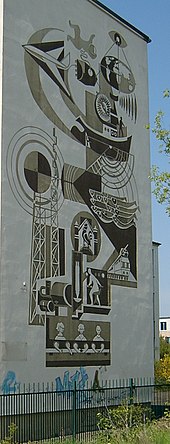Rudolf Grunemann
Rudolf Grunemann (born September 18, 1906 in Frankfurt (Oder) ; † April 9, 1981 there ) was a German painter , graphic artist , illustrator and wood cutter .
life and work
Rudolf Grunemann, born in Frankfurt (Oder) and raised in Dammvorstadt - today's Słubice - discovered his calling to art very early on. Encouraged and encouraged by the Frankfurt artist Max Heilmann , the trained photographer began his artistic training first as an autodidact, then studied in 1927 at the United State Schools for Free and Applied Arts in Berlin-Charlottenburg .
He became known, among other things, for the two photo folders about the art treasures of the Marienkirche in Frankfurt (Oder) , which he made at the end of the 1920s. Throughout his life, however, he was particularly interested in the Nordic cultural area, its people and its landscapes. From his numerous trips - in 1928 he made his first trip of several months to Lapland - through the whole of Northern Europe, Norway , Sweden , Denmark and Finland , and from his long stays among Lappish nomads in the 1920s and 1930s, one - despite considerable war losses - still very rich work of fantastic drawings, dreamlike pictures and photographs preserved. Especially his portraits , animal studies and landscape paintings made during this period still exert a very special charm today.
His travel diary about his first trip to the north in 1928 provides information about the enormous fascination that this region exerted on him. His two publications - one about Roald Amundsen , which was written in 1934, and a book of fairy tales "Der Sternenwagen", which he wrote and illustrated in 1941 for his eldest daughter - are also due to this fascination . In 1945 he took part in the first all-German exhibition in the Zeughaus Berlin , followed by several solo exhibitions in 1972 and 1978 in Frankfurt (Oder), as well as numerous participations in joint exhibitions in the region.
In the mid-1930s he then increasingly occupied himself with wall painting, using secco and fresco techniques . Building-related art and graphic productions also determined his work. In terms of the techniques and materials used , they are just as multifaceted as his topics. In addition, numerous illustrations were created in children's and non-fiction books.
Until his death in 1981, Rudolf Grunemann lived mainly in his hometown of Frankfurt (Oder). The artist left behind more than 3,000 works, some of which his building-related works can still be seen in the cityscape of Frankfurt today. Most of the drawings and pictures from the 1920s and 1930s, of which not too many have survived, are mostly in private hands. However, they show today's viewer a until then largely unknown Rudolf Grunemann.
Exhibitions
- May 5 - June 15, 2006, Adolf Schröter & Rudolf Grunemann, Frankfurter - Freunde - Artists, in the Marienkirche in Frankfurt (Oder)
- October 12 - November 12, 2006 "Rudolf Grunemann - a Frankfurt artist" in the Viadrina Museum in Frankfurt (Oder)
- July 2 - August 13, 2017 “What is art doing, Frankfurt (Oder)?” At the European University Viadrina with almost forgotten works of art from GDR days
Fonts
- Roald Amundsen. A pioneer in polar research. Lux, Murnau / Munich / Innsbruck / Olten 1934.
- The star chariot. Self-published, Frankfurt (Oder) 1935/1944.
Book illustrations
- Ernst Walter Huth: Guide through the district museum and the history of Frankfurt (Oder). I. part. Ed. District Museum Frankfurt (Oder). Self-published, Frankfurt (Oder) 1964.
- Gerhard Weise: About the wolf in sheep's clothing. Fables of German poets. Children's book publisher, Berlin 1957.
- German Central Institute for Teaching Aids (Ed.): Schull Tafel / Schoolplaat. Our fire department based on an original painting by Rudolf Grunemann. People and Knowledge People's own publishing house, Berlin 1959.
Web links
- moz.de: Mural "Germany united fatherland"
- Announcement exhibition City opens its depot for the exhibition "What makes art, Frankfurt (Oder)"
- New Germany of April 9, 1981: Obituary painter Rudolf Grunemann died in Frankfurt (fee required )
- Announcement of the exhibition at the Viadrina Museum in Frankfurt (Oder)
- Reliefs at the Lichtspieltheater der Jugend Frankfurt (Oder)
| personal data | |
|---|---|
| SURNAME | Grunemann, Rudolf |
| BRIEF DESCRIPTION | German artist |
| DATE OF BIRTH | September 18, 1906 |
| PLACE OF BIRTH | Frankfurt (Oder) |
| DATE OF DEATH | April 9, 1981 |
| Place of death | Frankfurt (Oder) |
